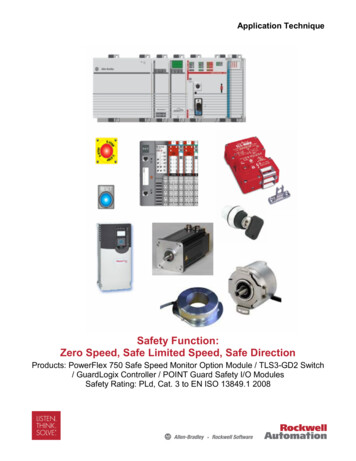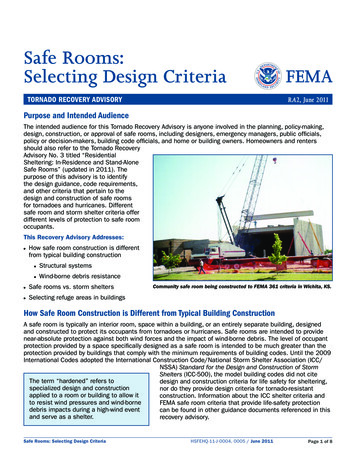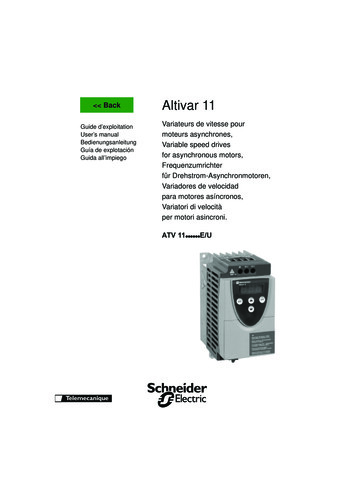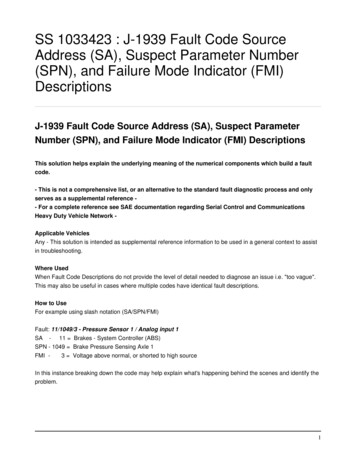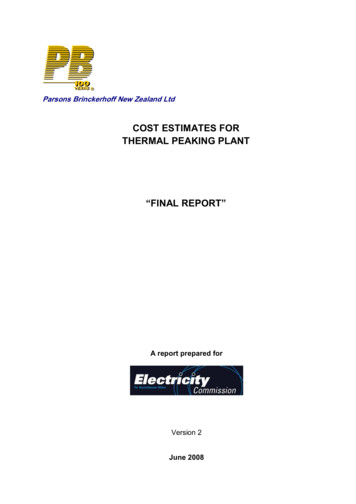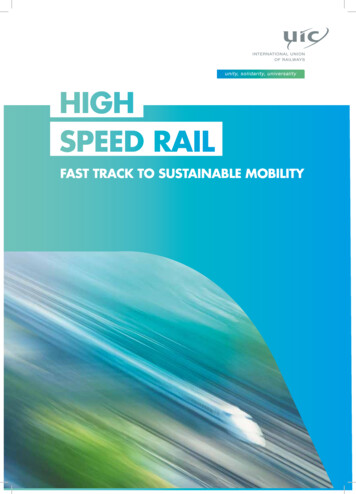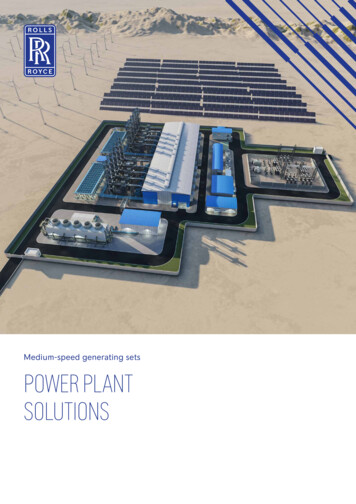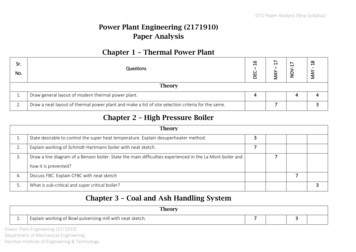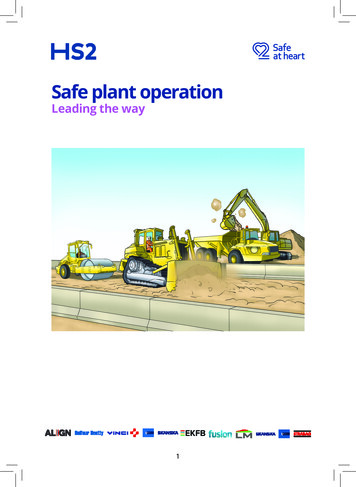
Transcription
Safe plant operationLeading the way1
IntroductionThe HS2 Safe Plant Working Group consists of representativesfrom HS2, the Enabling Works Contractors, the Main Works CivilsContractors (MWCC) and the Station contractors.This document explains the core initiatives that will drive down riskassociated with PIant to an absolute minimum.“As a group, we are committed to driving plant standards up to a newlevel, to minimise risks and eliminate plant related incidents, bothacross the HS2 programme and ultimately, through leaving a legacyof safer plant operation, across the wider construction industry.In preparing this new standard, we have consulted widely and drawnon examples of current best practice and emerging innovation fromall of the contractor organisations currently involved with HS2, ourrespective supply chains, equipment manufacturers and technologyproviders.This document aims to establish a consistent set of high standardsgoverning the operation of mobile construction plant on site, and toexplain the core initiatives we will introduce to reduce or eliminatethe risk of unplanned events or accidents involving mobile plantacross all HS2 sites. The standard follows on from, and incorporates,HS2’s On-site Plant People Interface document, published in 2018.The production of this new standard has been a truly collaborativeeffort. Going forward, we will continue to collaborate and learnlessons from each other and our stakeholders, embracing innovationand continuous improvement, and constantly reviewing performanceand effectiveness to ensure that together we protect our peopleand members of the public from the hazards associated with theoperation of construction plant.”Mark HarringtonChair of the HS2 Safe Plant Working Group2
HS2 Working Group CharterWe will: co-create detailed guidance for minimising the risk and eliminatingincidents associated with the operation of construction plant on site;make our guidance widely available, including publishing it on the HS2intranet;within that guidance, develop new processes, equipment standardsand competence requirements which will be followed by all contractorsworking on HS2;work with existing sources of good practice and recognise that change tothe higher standards needs to be managed to be most effective;focus on the key areas identified for change and make a difference in theseareas,consult and communicate with those who will be affected by the proposals;embrace technology and innovation, and continue to revisit the proposalsto achieve a standard which is genuinely inspiring;leave a legacy that transforms the construction industry.Safe at heartHS2 has committed to create a railway designed, built and operated to thehighest health, safety and security standards.Safety, as a core value for HS2, means caring for our workforce, ourpassengers and the public by creating an environment where no one getshurt.Safe at heart brings together and represents everything we aim to achievein health, safety and wellbeing at HS2 at every stage of the project. It setsout our: accountabilities as an industry leader and responsible client; expectations of all who work for and with HS2; caring approach to our workforce, neighbours and public; and commitment to giving health equal status to safety.Our Safe at heart principles of practice establish the baseline for acommon, consistent approach to health and safety during constructionand for our future operational workforce, passengers and public.They also lay the foundations for a collaborative approach to identifying,sharing and embedding best and innovative health and safety practice.To find out more about Safe at heart please visit www.hs2.org.uk andsearch ‘Safe at heart’.3
Key risks associated with PlantThis guidance document has been drawn up with a focus on thefollowing three key principles which have been identified as keycausal factors in plant incidents: safe people - guidance on competence of machine drivers andsupervisors; safe machines – guidance on machine selection, specificationand safety equipment; safe environment – guidance on work planning, appropriateconsideration of the environment where the plant is to be usedand increasing awareness of what to do if this changes.When operating plant on site, failure to adequately take into accountone or more of these factors will result in a rise in unnecessaryand preventable risk and expose the project to the potentialconsequences of that risk. consequences of that risk.4
These factors have been addressed through the consideration andimplementation of improvements in the following key focus areas: , ,In addition to the focus areas mentioned above, we have reviewedand updated the HS2 On site people vehicle interface document,published in 2018. It addressed key risks associated with the interfacebetween people and plant by focussing on the following key areas: standardisation and definition of working areas; harmonised PPE standards; improved visibility of people, mobile plant and vehicles; managing high risk areas; removing cabless variants of vehicles; controlling marshalling and lifting operations.This document enhances and updates the previous guidance,particularly in relation to definition of work areas and management ofhigh risk areas.Please note that the control of lifting operations is now subject toseparate HS2 guidance, and has been removed from the scope of thisdocument.5
We will:Work planning introduce the role of PlantAppointed Person. They will bea manager or supervisor withrelevant experience of managingconstruction plant and a strongunderstanding of the associatedhazards;ensure that the Plant AppointedPerson is an integral part of thework planning and approvalprocess;ensure, through the PlantAppointed Person, that anyrisks associated with the chosenplant and site environment areaddressed in the Works Plan;conduct an ongoing review ofplant operations, identifyingareas for further improvement.We will:Plant selection 6ensure, through our PlantAppointed Person, that plantis suitable for the tasks to beundertaken in terms of function,capacity and the prevailingworking environment;ensure, through our PlantAppointed Person, that plant isspecified correctly, including anyadditional or non-standard safetyequipment required to be fittedto the plant;ensure that any additional nonstandard or location specificcontrols or restrictions pertainingto the plant operation that maybe required are identified andincorporated into the works plan.
We will:Operatorcompetence regard the requisite PlantOperator Competency Scheme asa minimum requirement prior tofurther assessment;introduce a Licence to Operate asa requirement for all HS2 plantoperators. It will: involve a practical assessmentfor each type of plant they willoperate. Assessment criteriawill be standardised acrosssupply chain and training onthe assessment process andrequired standards will beprovided for relevant staff; assessments will be subject toaudit; form part of the HS2 SafetyPassport scheme.We will:Effectivesupervision 7ensure supervisors responsiblefor plant have the requiredknowledge and experience;provide training/mentoringfor supervisors to keep theirknowledge of plant up to date;involve supervisors at the WorkPlanning stage;require regular, documentedsite condition inspections to becarried out by supervisors as partof their everyday routine;create a “Super-controller” role,focussing on coordinating plantoperations in more complex orbusy mobile plant working areas.
We will:Plantspecification introduce Plant MinimumStandards across the HS2programme, which will include: mandating integrated tip-overprotection where available(e.g. ADT’s). This must includehydraulic cut-out to preventthe body being raised if themachine is at an unsafe angle. fitting aftermarket tip-overwarning devices to high riskmachines (e.g. mini excavators,forward tipping dumpers,compactors, telehandlers).These must be able to ensureearly warning of unsafe anglesin both lateral and transversedirections.We will:Technology andinnovation 8continue to engage with plantmanufacturers, technologyproviders and the wider industryso we remain at the leading edgeof innovation;consider operator fatigue/distraction monitoring camerasand pedestrian detection smartcameras to provide both instantoperator alerts and a videorecord of events to allow analysisand learning and inform theimplementation of preventativemeasures.
We will:Riskidentification increase emphasis on plantrisk at the work planning andoperational stage throughinvolving the Plant AppointedPerson at the Work Planningstage;involve plant operators andsupervisors at the Work Planningstage where appropriate;include more plant-focussedquestions in Point Of Work RiskAssessments (POWRAs), includingspecific assessment of prevailingground conditions and applicablecontrol measures.We will:Risk perceptionand awareness 9run site familiarisation andlocation specific briefings, whichwill be a requirement for all plantoperators before they start workat any new location. This willinclude an on-site assessment ofthe work location;increase awareness throughregular plant-focussed standdowns/briefing;introduce additional controlmeasures for what areconsidered to be high riskitems of plant. This may includespecific additional seniormanager authorisations, permitsto operate particular items ofequipment, additional operatorfamiliarisation and training oradditional task supervision.
ChangeIdentification andCommunicationWe will: 10introduce a Predict & Preventprocess to consider potentialchange at the work planningstage. This process will involve: considering what could changeduring a task that may renderthe plant selection unsuitableor increase associated risk; what could be done to preventor reduce the chances of thechange event happening; identifying a course of action totake if the change event occurs;document the outcome of thisprocess in the work plan andensure that it forms part of thetask briefings, to help to raiseworkforce awareness aroundunderstanding of change events.
On site people vehicle interfaceStandardisationand definition ofworking areasWe will: ensure that adequate segregationis provided to keep people awayfrom plant operations throughthe introduction of a 4 colourcoded system to identify non-plantworking areas, permanent restrictedareas, managed segregation areasand close proximity working area;include zoning and situation layoutsin onboarding sessions and explainchanges in daily site briefings; andintroduce additional controls in highrisk areas, including authorisationby senior managers, additional taskrelevant training for operatives anddedicated task specific supervision;use technology to monitoradherence to the zoningrequirements.Site zoning and segregation of plant operations11
Harmonised PPEstandardsWe will: Improvedvisibility ofpeople, mobileplant andvehiclesstandardise PPE and, whereappropriate, fit light emittingtechnology to improve visibility;ensure mobile plant operators’ PPEis sized and selected to preventinadvertent snagging on controls;andhave a standard of colour codingfor safety helmets across HS2, to befollowed without exception.We will: 12replace beacon light systems onall public highway works mobileplant/vehicles with light emittingtechnology to enhance vehiclevisibility for approaching trafficand eliminate ‘light blindness’(mandatory from 2021 onwards);andwork with equipmentmanufacturers to investigateways of enhancing currentsystems and introduce ‘daybright’ technology by 2021.
Managing highrisk areasWe will: Remove cablessvariants ofvehiclesprovide everyone working in highrisk areas with specific training;allocate marshals to individualsand a responsible person togangs working in high risk areasto control activity;use hands free, two-waycommunication systems betweenthose working in these areas; anddevelop a system that warns ofpedestrians’ proximities aroundmobile plant, and continue toinnovate in this area.We will: 13introduce dual view or lowerprofiled forward tippingdumpers;replace mini excavators androllers with cabbed variants;require authorisation by principalcontractor site senior managersin cases when the need forcabless plant is unavoidable; andidentify authorised plant viaa distinct placard with therespective authorisation to do so.
The futureWe will: 14with regards to equipment fittedto mobile plant, test the newstandard for suitability and ifaccepted, issue a standardisedprotocol including: intrusion alarms warning thosein the high risk area as well asplant operators and others; data recording and reportingon unauthorised intrusionsinto high risk areas; and reactive PPE warning ofintrusion;look to introduce the controlsimplemented for mobile plantaround other high risk areas;work with equipmentmanufacturers so that plant,vehicles and PPE comes fittedwith safety critical equipment asstandard;work with industry to furtherstandardise the terminology usedthat affects PVI; andproduce further documentationand case studies to shareour learning across the widerindustry.
15
Mobile plant minimum requirements180 Excavator/Backhoe EU engine emissions to Stage IVRoll over protection structure (ROPS) to cab and Falling objects protectivestructure (FOPS) based on working environment/where required by riskassessment Seat belts fitted & operational External green beacon (to indicate when the seat belt is fastened) Mirrors/colour CCTV to satisfy 1m high at 1m distance visibility criteria Movement alarm (white noise) with night/day switch Slope indicator/tip over warning device (early warning with horizontal/vertical angle measurement) Flashing amber beacon Work at height protection to provide safe environment when on themachine for refueling and maintenance etc Handrails on body where access required Check valves must be fitted to excavators’ boom and dipper circuits Glass hammer fitted in cabIf quick hitch fitted: Must be fully automatic double locking for machines over 5 tonnes (unlessdirect attachment-no quick hitch) Have an in-cab warning alarm Copy of manufacturers operating instructionsLifting Six-month thorough examination on lifting accessories Audible or visual overload warning system fitted and operational Certified lifting point required for all lifting duties SWL to be clearly marked on all lifting points Duty chart Grade 8 Alloy bow shackle & swivel safety hookIf used under overhead cables or obstructions: Height restrictors with indication on machineDesirable Pedestrian detection smart camera Operator fatigue/distraction monitoring system16
360 Excavator Tracked EU engine emissions to Stage IVRoll over protection structure (ROPS) to cab and Falling objects protectivestructure (FOPS) based on working environment/where required by riskassessment Seat belts fitted & operational External green beacon (to indicate when the seat belt is fastened) Mirrors/colour CCTV to satisfy 1m high at 1m distance visibility criteria Movement alarm (white noise) with night/day switch Slope indicator/tip over warning device (early warning with horizontal/vertical angle measurement) Flashing amber beacon Work at height protection to provide safe environment when on themachine for refueling and maintenance etc Handrails on body where access required Check valves must be fitted to excavators’ boom and dipper circuits Glass hammer fitted in cabIf quick hitch fitted: Must be fully automatic double locking for machines over 5 tonnes (unlessdirect attachment-no quick hitch) Have an in-cab warning alarm Copy of manufacturers operating instructionsLifting Six-month thorough examination on lifting accessories Audible or visual overload warning system fitted and operational Certified lifting point required for all lifting duties SWL to be clearly marked on all lifting points Duty chartIf used under overhead cables or obstructions: Height restrictors with indication on machineDesirable Pedestrian detection smart camera Operator fatigue/distraction monitoring system17
360 Excavator Wheeled EU engine emissions to Stage IVRoll over protection structure (ROPS) to cab and falling objects protectivestructure (FOPS) based on working environment/where required by riskassessment Seat belts fitted & operational External green beacon (to indicate when the seat belt is fastened) Mirrors/colour CCTV to satisfy 1m high at 1m distance visibility criteria Movement alarm (white noise) with night/day switch Slope indicator/tip over warning device (early warning with horizontal/vertical angle measurement) Axel/stabiliser locks Flashing amber beacon Work at height protection to provide safe environment when on themachine for refueling and maintenance etc Handrails on body where access required Check valves must be fitted to excavators’ boom and dipper circuits Glass hammer fitted in cabIf quick hitch fitted: Must be fully automatic double locking for machines over 5 tonnes (unlessdirect attachment-no quick hitch) Have an in-cab warning alarm Copy of manufacturers operating instructionsLifting Six-month thorough examination on lifting accessories Audible or visual overload warning system fitted and operational Certified lifting point required for all lifting duties SWL to be clearly marked on all lifting points Axel/stabiliser locks Duty chart Grade 8 Alloy bow shackle & swivel safety hookIf used under overhead cables or obstructions: Height restrictors with indication on machineDesirable Pedestrian detection smart camera Operator fatigue/distraction monitoring system18
Articulated Dump Truck (ADT) EU engine emissions Stage IV in line with the current NRMM standardsROPS & FOPS cab structure c/w safety glassMirrors / CCTV – to satisfy 1m high at 1.m distance rule 360 visibilitycriteria Additional visual aids (e.g. multiple mirrors, cameras) to eliminate blindspots Seat belt fitted & operational, External seat belt indicator beacon Flashing amber beacon White noise reversing alarm (night/day switch) Locking fuel caps/covers Isolation switch with key Safe and suitable access/egress for the operator to enter/exit the machineand for maintenance (handrails and steps ensure 3 points of contact) Skip raised audible visual warning alarm Articulation lock must be fitted and operational Mechanical prop fitted under body Fire extinguisher fitted in cab and in date Integrated tip over protection – skip inclinometer with in-cab warning – withhydraulic tip function isolation when approaching/at unsafe angles ( 20tonne)Desirable Pedestrian detection smart camera Operator fatigue/distraction monitoring system19
Agricultural tractor EU engine emissions Stage IVROPS cab structureSeat belt fitted & operationalExternal seat belt indicator beacon360 visibility mirrors/CCTV – to satisfy 1.m high at 1.m distance ruleAdditional visual aids (e.g. multiple mirrors, cameras) to eliminate blindspots All PTO drives adequately guarded Amber flashing beacon White noise reversing alarm (night/day switch) Work lights fitted front and rear Tractor and any trailers used must have compatible hitch points. Slope indicator (horizontal/vertical angle measurement with audio visualwarning) Safe and suitable access/egress for the operator to enter/exit the machineand for maintenance (handrails and steps to ensure 3 points of contact) Locking fuel caps For public highway use – must comply with The Road Vehicle (Construction& Use) Regulations (indicators, registration plates front and rear etc) If used for towing, must have hydraulic and air braking capability Manufacturers handbook and operator instructionsDesirable Pedestrian detection smart camera Operator fatigue/distraction monitoring system20
Compaction roller Protected cab or FOPS cab structure where risk of falling objectsSeat belts must be fitted and operationalExternal seat belt indicator beaconFlashing amber beaconFitted with front and rear scraper bars on drum/sIntegral water supply to drumLocking doors with key – for all glazed cab machinesCab steps and grab handles to ensure 3 points of contact is achievable andpreferably high visibility (ensure 3 points of contact) Mirrors/CCTV to ensure 1m high at 1m distance visibility criteria White noise reversing alarm Under seat starter/isolator pressure switch Locking caps/covers to fuel and all other tanks Isolation switch with key Slope indicator (horizontal/vertical angle measurement with audio visualwarning) Manufacturers handbook and operator instructions For public highways use – must be compliant with The Road Vehicles(Construction & Use) Regulations (lights, indicators, registration plate’sfront & rear etc.)Desirable For rollers with enclosed cabs – pedestrian detection smart cameras Operator fatigue/distraction monitoring system21
Forward/side tipping dumper (cab) EU engine emissions stage IVForward/reverse driving positionMinimum equipment age – 4 years (except by prior agreement)Operator protection system (OPS) front (skip facing) guardROPS cabFOPS cab Level 2 protectionSeat belts fitted & operationalSeat belt indicator beaconMirrors – to satisfy 1 m high at 1 m distance ruleAdditional visual aids (e.g. multiple mirrors, cameras, etc.) to eliminate blindspots Forward collision avoidance system (proximity sensor or forward-facingcamera or similar approved) to ensure 1.5m high @ 1.0m distance visibilitycriteria. Rear-facing camera Slope indicator/tip over warning device (Early warning with horizontal/vertical angle measurement) Rachet and release button type handbrake Flashing amber beacon White noise reversing alarm (night/day switch) Locking fuel caps/covers Isolation switch with key Lights fitted (for public highway use – must be compliant with RoadVehicles (Construction and Use) Regulations – indicators, registration platesetc. A specific decal stating the dumper MUST not be loaded above the rim ofthe skip Mechanical prop fitted under body Safe and suitable access/egress for the operator to enter/exit the machineand for maintenance (ensure 3 points of contact) Manufacturers handbook and operator instructions Tow hitch (for recovery purposes) fitted with correct pin c/w securing chainDesirable Pedestrian detection smart camera Operator fatigue/distraction monitoring system22
General requirements Compliant with current UK legislationCompliant with EC Machinery Directive 2006/42/EC and supplied with adeclaration of conformity Evidence of pre-hire inspection Evidence of regular inspection plus ‘next service and or inspection due’date/hours sticker All plant to be inspected prior to first use and the appropriate pre-startcheck sheet completed and daily recorded inspections thereafter Pre -start check sheet to be retained in the cab and made available forinspection on request Operator instruction manual available with plant/machine at all times All safety decals in place and legible. Plant access handrails and steps to be of a conspicuous colour wherepossible Wheel Nut indicators on all wheel nuts unless proved impractical The operation of the emergency stop buttons and any other isolatingdevices must be checked for operational function If used on the public highway, mobile plant must meet the requirementsof The Road Vehicle (Construction and Use) Regulations and Vehicle Exciseand Registration Act Operator’s driving licences should be checked against DVLA requirementsto ensure correct categories are held and any age restrictions compliedwithPlant undertaking lifting operations Report of thorough examination within the past 12 months Report of thorough examination within the past 6 months for all liftingaccessories Lifting duty chart for current machine configuration23
Grader EU engine emissions Stage IVROPS cab structure c/w safety glassMirrors / CCTV – To satisfy 1.5m high at 1.0m distance rule 360 visibilitycriteria Additional visual aids (e.g. multiple mirrors, cameras) to eliminate blindspots Seat belt fitted and operational Seat belt indicator beacon Flashing amber beacon White noise reversing alarm Locking fuel caps/covers Isolation switch with key There must be safe and suitable access/egress for the operator to enter/exit the machine and for maintenance (e.g. handrails and steps) Wheel nut indicators Fire extinguisher fitted in cab Safety bar pivot pin and clearly marked Operator’s handbookPlant undertaking lifting operations Operator fatigue/distraction monitoring system Pedestrian detection smart camera24
Mini excavator (under 10 tonnes) EU engine emissions to Stage IVRoll over protection structure (ROPS) to cab and Falling objects protectivestructure (FOPS) based on working environment/where required by riskassessment Seat belts fitted & operational External green light (to indicate when the seat belt is fastened) Mirrors/colour CCTV to satisfy 1m high at 1 m distance visibility criteria Slope indicator/tip over warning device (Early warning with horizontal/vertical angle measurement) Movement alarm (white noise) with night/day switch Flashing amber beacon Work at height protection to provide safe work environment when on themachine for refueling and maintenance etc Handrails on body where access required (ensure 3 points of contact) Check valves must be fitted to excavators’ boom and dipper circuits Glass hammer fitted in cabIf quick hitch fitted: Must be fully automatic double locking for machines over 5 tonnes (unlessdirect attachment-no quick hitch) Have an in-cab warning alarm Copy of manufacturers operating instructionsLifting Six-month thorough examination on lifting accessories Audible or visual overload warning system fitted and operational Certified lifting point required for all lifting duties SWL to be clearly marked on all lifting points Duty chartIf used under overhead cables or obstructions: Height restrictors with indication on machineDesirable Pedestrian detection smart camera Operator fatigue/distraction monitoring system25
Telehandler Engine tier stage IVROPS and FOPS protection cabSupplied with lights (for public highway use must be Road Vehicle(Construction and Use) Regulations compliant) Flashing amber beacon Mirrors/CCTV to satisfy 1m high at 1m distance visibility criteria Locking doors with keys Isolation switch with key Slope indicator (horizontal/vertical angle measurement with early audiovisual warning) Cab steps and grab handles to ensure 3 points of contact is achievable Seat belts fitted and operational White noise reversing alarm (night/day switch) Where access is required at height for security and maintenance purposes,protective measures bust be in place to prevent falling for height SWL to be clearly marked Audio/visual overload system warning device Check valves must be fitted Locking caps/covers to fuel and other tanks Boom ram lock facility The towing ability of the telehandler is limited to the manufacturersrecommendations, type of towing hitch fitted, the braking system of thetrailer and road weight restrictionsIf used under overhead cables or obstructions: Height restrictors with indication on machineDesirable Pedestrian detection smart camera Operator fatigue/distraction monitoring system26
Tracked dozer EU engine emissions to Stage IVRoll over protection structure (ROPS) to cab and Falling objects protectivestructure (FOPS) based on working environment/where required by riskassessment Seat belts fitted and operational Mirrors CCTV to satisfy 1m high at 1-metre distance criteria Movement alarm (white noise) with night/day switch Flashing amber beacon Work at height protection to provide safe work environment when on themachine for refueling and maintenance etc Handrails on body where access required (ensure 3 points of contact) External green light (to indicate when the seat belt is fastened) Locking caps/covers to fuel and all other tanks Manufacturers handbookIf winch fitted: Report of Thorough examination for lifting accessoriesDesirable Pedestrian detection smart camera Operator fatigue/distraction monitoring system Refuelling point accessible from ground level27
1MC12 - Stage Two - Main Works Civils for C2 and C3 SectorsPlant operator practical competency assessmentsDump truckDate:Operator informationOperators name:Operator signature:Employing company:Item of plant used:ADTMake and model:Previous assessment date:QualificationsYesFleet number:NoValid fromExpiryCategories on qualificationCPCS cardNVQOtherAssessor informationAssessor name:Assessor signature:Position:YesNoHas the assessment process been explained to the operator?Is the operator aware of the re-fuelling procedures?Does the operator have a good understanding of the site rules and safetyrequirements?Is the operator aware of the spill response procedures?Can the operator hear external reversing/warning alarms under normal conditions?Can the operator read information and warning signs from an reasonable distance?Has the operator selected the appropriate PPE for the task?Pre-Start ChecksIs the appropriate sheet being used to record pre-start inspection?Were the pre-start checks carried out correctly? (as per manufactures procedures)Did the operator carry out lubrication and fluid checks? (as per manufacturesprocedures)Did the operator check steps and handrails and clean as necessary?Was access to the machine gained in a safe manner?Were any operator adjustments carried out correctly and safely?Did the operator check the function of all safety features?Is the operator able to comment on the significance of each condition monitoringdevice and instrument readings? (symbols)Were the machine controls identified correctly?Have any defects been identified, recorded and reported to a supervisor?28Authoriser: Dan KirbyDocument Owner: Martyn Bishop1Documen
(e.g. ADT's). This must include hydraulic cut-out to prevent the body being raised if the machine is at an unsafe angle. fitting aftermarket tip-over warning devices to high risk machines (e.g. mini excavators, forward tipping dumpers, compactors, telehandlers). These must be able to ensure early warning of unsafe angles

